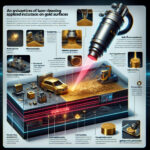Laser cleaning for removing contaminants from leather surfaces
- Introduction to laser cleaning technology
- History of laser cleaning in leather industry
- Comparison of laser cleaning with traditional cleaning methods
- Future trends in laser cleaning for leather surfaces
- Limitations of laser cleaning technology for leather surfaces
- Applications of laser cleaning in different industries
- Challenges faced in implementing laser cleaning for leather
- Impact of laser cleaning on the durability of leather
Introduction to laser cleaning technology
Laser cleaning technology is a cutting-edge method used to remove contaminants, coatings, rust, and other unwanted materials from surfaces. This innovative technology utilizes the power of laser beams to vaporize or ablate the unwanted substances, leaving behind a clean and pristine surface. Laser cleaning is becoming increasingly popular in various industries due to its efficiency, precision, and environmentally friendly nature.
How does laser cleaning work?
Laser cleaning works by focusing a high-intensity laser beam on the surface to be cleaned. The energy from the laser beam interacts with the contaminants on the surface, causing them to either vaporize or ablate. The process is highly precise, allowing for selective removal of specific materials without damaging the underlying surface. Laser cleaning is non-contact, meaning there is no physical contact between the cleaning equipment and the surface, reducing the risk of damage or contamination.
Benefits of laser cleaning technology
– Efficiency: Laser cleaning is a fast and efficient method of removing contaminants from surfaces. It can clean large areas in a short amount of time, increasing productivity and reducing downtime.
– Precision: Laser cleaning allows for precise control over the cleaning process, ensuring that only the unwanted materials are removed without damaging the underlying surface.
– Environmentally friendly: Laser cleaning is a clean and environmentally friendly method of surface cleaning. It does not require the use of chemicals or solvents, reducing the impact on the environment.
– Cost-effective: While the initial investment in laser cleaning technology may be higher than traditional cleaning methods, the long-term cost savings can be significant. Laser cleaning is a low-maintenance and durable technology that can provide a high return on investment.
Applications of laser cleaning technology
Laser cleaning technology has a wide range of applications across various industries, including:
– Automotive: Laser cleaning is used to remove rust, paint, and other contaminants from car bodies and components.
– Manufacturing: Laser cleaning is used to clean molds, tools, and equipment in manufacturing processes.
– Historical preservation: Laser cleaning is used to clean delicate artifacts and historical buildings without causing damage.
– Aerospace: Laser cleaning is used to clean aircraft components and engines, ensuring optimal performance and safety.
In conclusion, laser cleaning technology is a cutting-edge method that offers numerous benefits for surface cleaning. Its efficiency, precision, and environmentally friendly nature make it a popular choice for industries looking to improve their cleaning processes.
#laser #cleaning #technology
Keywords: laser cleaning, surface cleaning, efficiency, precision, environmentally friendly
Long-tail phrases: laser cleaning technology applications, benefits of laser cleaning, how does laser cleaning work.
History of laser cleaning in leather industry
Over the years, laser cleaning technology has continued to evolve and improve, with advancements in laser power and precision allowing for more effective and efficient cleaning of leather surfaces. Today, laser cleaning is widely used in the leather industry for a variety of applications, including the removal of dirt, grease, and other contaminants from leather products.
One of the key benefits of laser cleaning in the leather industry is its ability to reduce the use of harmful chemicals and solvents, making it a more environmentally friendly option for cleaning leather surfaces. Additionally, laser cleaning is a faster and more cost-effective method compared to traditional cleaning methods, saving time and resources for leather manufacturers.
In conclusion, the history of laser cleaning in the leather industry has been marked by continuous innovation and improvement, leading to a more efficient and sustainable method of cleaning leather surfaces. As technology continues to advance, laser cleaning is expected to play an even greater role in the leather industry, providing a cleaner and more environmentally friendly solution for leather cleaning.
- Efficient cleaning method
- Environmentally friendly
- Cost-effective
- Reduces use of harmful chemicals
- Improves quality and durability of leather
- Revolutionized leather cleaning
- Advanced laser technology
- Environmentally sustainable
- Efficient and effective cleaning
- Cost-saving solution
#laser #cleaning #leather #industry #technology
Comparison of laser cleaning with traditional cleaning methods
One of the key advantages of laser cleaning is its precision and control. The intensity and focus of the laser beam can be adjusted to target specific contaminants without damaging the underlying surface. This level of precision is particularly beneficial in industries where delicate or complex parts need to be cleaned without causing damage.
Another advantage of laser cleaning is its environmental friendliness. Unlike traditional cleaning methods that rely on harsh chemicals and abrasive materials, laser cleaning is a dry process that does not produce any waste or emissions. This makes it a more sustainable and eco-friendly option for industries looking to reduce their environmental impact.
In terms of efficiency, laser cleaning is also superior to traditional methods. The process is faster and more effective, requiring less time and labor to achieve the same level of cleanliness. This can result in cost savings for companies in terms of reduced downtime and increased productivity.
Despite its many advantages, laser cleaning also has some limitations. The initial cost of purchasing and maintaining laser cleaning equipment can be high, making it less accessible for small businesses or those with limited budgets. Additionally, laser cleaning may not be suitable for all types of contaminants or surfaces, requiring a thorough understanding of the material properties and laser parameters.
In comparison, traditional cleaning methods have been tried and tested for many years and are generally more affordable and accessible. Chemical cleaning, for example, is effective for removing grease, oil, and other organic contaminants, while abrasive blasting is ideal for removing rust, paint, and scale. Ultrasonic cleaning, on the other hand, uses high-frequency sound waves to agitate a cleaning solution and remove contaminants from intricate parts.
In conclusion, the choice between laser cleaning and traditional cleaning methods depends on the specific requirements of the application. While laser cleaning offers precision, efficiency, and environmental benefits, traditional methods are still relevant for certain cleaning tasks. Ultimately, companies should consider factors such as cost, accessibility, and the nature of contaminants when deciding on the most suitable cleaning method for their needs.
#laser cleaning, #traditional cleaning methods, #precision cleaning, #environmentally friendly cleaning, #industrial cleaning
frazy kluczowe:
– advantages of laser cleaning over traditional methods
– limitations of laser cleaning
– cost comparison of laser cleaning and traditional methods
– environmental impact of cleaning methods
– efficiency of laser cleaning in industrial applications
Future trends in laser cleaning for leather surfaces
Advancements in laser cleaning technology
One of the key trends in laser cleaning for leather surfaces is the development of more powerful and efficient laser systems. These systems are capable of delivering higher energy levels and shorter pulse durations, allowing for faster and more effective cleaning. Additionally, advancements in laser beam delivery systems have made it possible to clean leather surfaces with greater precision and control.
Integration of automation and robotics
Another trend in laser cleaning for leather surfaces is the integration of automation and robotics. This allows for the development of fully automated cleaning systems that can be programmed to clean leather surfaces with minimal human intervention. These systems are not only more efficient but also reduce the risk of human error and ensure consistent cleaning results.
Environmental sustainability
As the demand for environmentally friendly cleaning solutions continues to grow, laser cleaning technology is becoming increasingly popular for its minimal environmental impact. Unlike traditional cleaning methods that use harsh chemicals and produce harmful waste, laser cleaning is a clean and sustainable solution that does not generate any secondary waste. This makes it an attractive option for leather manufacturers and consumers alike.
Cost-effectiveness
While laser cleaning technology may have a higher upfront cost compared to traditional cleaning methods, it offers long-term cost savings due to its efficiency and reduced maintenance requirements. With advancements in laser technology and increased competition in the market, the cost of laser cleaning systems is expected to decrease, making it a more accessible option for leather cleaning applications.
Conclusion
Overall, the future of laser cleaning for leather surfaces looks promising, with advancements in technology driving greater efficiency, precision, and sustainability. As the demand for environmentally friendly cleaning solutions continues to grow, laser cleaning technology is expected to play a key role in shaping the future of leather cleaning.
| Future trends | Advancements | Integration | Environmental sustainability | Cost-effectiveness |
|---|---|---|---|---|
| More powerful and efficient laser systems | Development of laser beam delivery systems | Automation and robotics | Minimal environmental impact | Long-term cost savings |
#laser #cleaning #leather #surfaces #technology #environment #sustainability #cost #efficiency #automation
Keywords: laser cleaning, leather surfaces, technology, sustainability, cost-effectiveness, automation
Long-tail phrases: future trends in laser cleaning for leather surfaces, advancements in laser cleaning technology, integration of automation and robotics, environmental sustainability in laser cleaning, cost-effectiveness of laser cleaning for leather surfaces.
Limitations of laser cleaning technology for leather surfaces
1. Sensitivity of leather
Leather is a natural material that is sensitive to heat and light. When exposed to high-intensity laser beams, leather can easily get damaged or discolored. This limits the power and intensity of the laser that can be used for cleaning leather surfaces.
2. Surface texture
Leather surfaces often have a textured finish, which can make it difficult for laser beams to reach all areas evenly. This can result in uneven cleaning and potential damage to the surface of the leather.
3. Chemical reactions
Some types of leather may react chemically when exposed to laser beams, leading to discoloration or other unwanted effects. It is important to test the compatibility of the laser cleaning technology with the specific type of leather being cleaned.
4. Thickness of the leather
The thickness of the leather can also affect the effectiveness of laser cleaning technology. Thicker leather may require higher power levels, which can increase the risk of damage to the surface.
5. Cost
Investing in laser cleaning technology for leather surfaces can be expensive, especially for small businesses or individuals. The cost of purchasing and maintaining the equipment, as well as training operators, can be a significant barrier to adoption.
Conclusion
While laser cleaning technology offers many benefits, including efficiency and precision, there are limitations when it comes to cleaning leather surfaces. It is important to consider the sensitivity of leather, surface texture, chemical reactions, thickness, and cost before using laser cleaning technology on leather.
| Limitation | Description |
|---|---|
| Sensitivity of leather | Leather is sensitive to heat and light, making it prone to damage when exposed to high-intensity laser beams. |
| Surface texture | Textured finishes on leather surfaces can make it difficult for laser beams to clean evenly. |
| Chemical reactions | Some types of leather may react chemically to laser beams, causing discoloration or other unwanted effects. |
| Thickness of the leather | Thicker leather may require higher power levels, increasing the risk of damage to the surface. |
| Cost | Investing in laser cleaning technology for leather surfaces can be expensive, posing a barrier to adoption. |
#leather #laser #cleaning #technology #limitations
Sensitivity of leather, surface texture, chemical reactions, thickness of the leather, cost
Applications of laser cleaning in different industries
Automotive Industry
In the automotive industry, laser cleaning is used for removing rust, paint, and other contaminants from car bodies, engine parts, and other components. It is a precise and efficient method that helps improve the quality of the surface preparation process and ensures better adhesion of coatings and paints.
| Application | Benefits |
|---|---|
| Rust removal | Improved surface quality |
| Paint stripping | Efficient and precise |
Manufacturing Industry
In the manufacturing industry, laser cleaning is used for removing oxides, coatings, and other contaminants from metal surfaces. It is a fast and cost-effective method that helps improve the quality of the final product and reduces the need for manual cleaning processes.
| Application | Benefits |
|---|---|
| Surface preparation | Improved product quality |
| Coating removal | Cost-effective |
Electronics Industry
In the electronics industry, laser cleaning is used for removing solder residues, oxides, and other contaminants from circuit boards and electronic components. It is a precise and non-destructive method that helps improve the reliability and performance of electronic devices.
| Application | Benefits |
|---|---|
| Solder residue removal | Improved reliability |
| Oxide removal | Enhanced performance |
Overall, laser cleaning is a versatile technology that offers numerous benefits in various industries, including automotive, manufacturing, and electronics. Its non-contact nature, precision, and efficiency make it an attractive choice for cleaning and surface preparation applications.
#laser #cleaning #industries #automotive #manufacturing #electronics
applications, laser cleaning, different industries, surface preparation, non-contact, contaminants, coatings, rust, paint, automotive industry, manufacturing industry, electronics industry, precision, efficiency, reliability, performance, oxide removal, solder residue removal, cost-effective, improved product quality, improved surface quality, enhanced performance, paint stripping, rust removal.
Challenges faced in implementing laser cleaning for leather
- Compatibility: One of the main challenges in implementing laser cleaning for leather is ensuring that the laser is compatible with the specific type of leather being cleaned. Different types of leather may react differently to laser cleaning, so it is important to test the process on a small sample before applying it to a larger area.
- Surface damage: Laser cleaning can be a very powerful process, and if not used correctly, it can cause damage to the surface of the leather. It is important to carefully control the intensity and duration of the laser to avoid burning or discoloration of the leather.
- Cost: Implementing laser cleaning technology can be expensive, especially for smaller leather manufacturers. The initial investment in the equipment and training can be a barrier for some companies, but the long-term benefits of laser cleaning may outweigh the costs.
- Regulations: There may be regulations and safety standards that need to be met when implementing laser cleaning technology in a leather production facility. It is important to ensure that the equipment is properly installed and maintained to comply with these regulations.
In conclusion, while laser cleaning technology offers many benefits for the leather industry, there are several challenges that need to be addressed in order to effectively implement this technology. By carefully considering compatibility, surface damage, cost, and regulations, leather manufacturers can successfully integrate laser cleaning into their production processes.
#laser #cleaning #leather #challenges #implementation
#compatibility #surface damage #cost #regulations
Impact of laser cleaning on the durability of leather
One of the key benefits of laser cleaning is its impact on the durability of leather. By removing dirt and stains from the surface of the leather, laser cleaning can help to prevent the buildup of grime and debris that can weaken the material over time. This can extend the lifespan of leather products and help them maintain their appearance for longer.
Additionally, laser cleaning can also help to restore the natural oils and moisture in leather, which can help to prevent drying and cracking. By gently removing dirt and stains from the surface of the leather, laser cleaning can allow the material to breathe and retain its natural flexibility and softness. This can help to maintain the overall quality and appearance of leather products over time.
In conclusion, laser cleaning can have a positive impact on the durability of leather by gently removing dirt and stains from the surface of the material without causing any damage. This non-contact cleaning method can help to extend the lifespan of leather products and maintain their appearance for longer.
#leather #durability #laser cleaning #cleaning #material #luxurious #flexibility #stains #dirt #non-contact #gentle #moisture #appearance
frazy kluczowe:
– impact of laser cleaning on leather durability
– benefits of laser cleaning for leather products
– non-contact cleaning method for leather
– extending the lifespan of leather products with laser cleaning
– maintaining the appearance of leather with laser cleaning.


